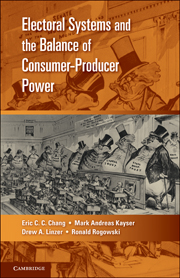Book contents
- Frontmatter
- Contents
- Acknowledgments
- 1 Introduction
- 2 Electoral Systems and Consumer Power: Theoretical Considerations
- 3 Electoral Systems and Real Prices: Panel Evidence for the OECD Countries, 1970–2000
- 4 Electoral Systems and Real Prices around the World
- 5 A Closer Look: Case Studies and Mechanisms
- 6 Socioeconomic Origins of Electoral Systems
- 7 Conclusion
- Bibliography
- Index
2 - Electoral Systems and Consumer Power: Theoretical Considerations
Published online by Cambridge University Press: 05 June 2012
- Frontmatter
- Contents
- Acknowledgments
- 1 Introduction
- 2 Electoral Systems and Consumer Power: Theoretical Considerations
- 3 Electoral Systems and Real Prices: Panel Evidence for the OECD Countries, 1970–2000
- 4 Electoral Systems and Real Prices around the World
- 5 A Closer Look: Case Studies and Mechanisms
- 6 Socioeconomic Origins of Electoral Systems
- 7 Conclusion
- Bibliography
- Index
Summary
We begin with some fundamental and still highly influential work on regulation and its effects by two leading economists of the mid-twentieth century, George Stigler and Sam Peltzman. We then move to develop a specific Stigler-Peltzman political support function and analyze the role of electoral responsiveness in it. We next consider possible welfare and distributional effects of regulated, high-price economic systems. We then consider how the analysis might differ in a small, open, export-dependent economy. Then, having analyzed the effect of various kinds of democratic constitutions, we consider some of the implications for nondemocracies, weakly institutionalized democracies, and less developed economies. Finally, we consider whether electoral systems can be regarded as exogenous and whether this affects our overall analysis.
The Stigler-Peltzman Framework
The essential insight of the Stigler-Peltzman (S-P) analysis of regulation can be conveyed by a single and widely familiar diagram shown in Figure 2.1 (cf. Peltzman 1976, p. 224). Suppose that the price of a given industry's product is represented on the horizontal axis and its profits on the vertical one. At the perfectly competitive price (pc), profits will be zero. To the extent that regulation in any of its familiar forms – licensure schemes that artificially restrict supply, regulatory boards that set minimum prices, impediments to efficient retailing, tariffs, quotas, and so on – raises the product's price above this competitive level, total industry profits begin to rise until price reaches the level that a monopoly would impose; this is denoted as pm. If regulation becomes so restrictive of supply as to push price even beyond this monopolistic level, industry profits again decline, returning to zero (or even becoming negative) as the price becomes prohibitive.
- Type
- Chapter
- Information
- Publisher: Cambridge University PressPrint publication year: 2010



